Deserts cover approximately one-third of the Earth’s surface (and are on every continent, including Antarctica). But how do deserts form, and why are deserts essential to the health of the planet? Read on to better understand the world’s four types of deserts (no, they aren’t all just hot and sandy), including why they form where they do, and how they help regulate the climate.
Thinking of a desert safari? You’ll learn about some of the world’s most important deserts and desert survival tips. If you need to transfer money to make your desert holiday a reality, use Remitly to send money with confidence.
What makes a desert?
The widely accepted definition of a desert is a dry ecosystem that receives fewer than 10 inches (25 centimeters) of rain each year. We often picture deserts as hot, sandy environments where the burning sun evaporates any water quickly, resulting in sparse vegetation. While this is a fairly accurate description, there are four distinct types of deserts:
- Hot and dry deserts: These are your classic deserts, characterized by extreme temperatures (hot during the day and cold at night), limited rainfall, little vegetation, with rolling sand dunes and rocky plains. Think of the Sahara Desert.
- Semiarid deserts: These are deserts that receive a bit more rainfall and so are more likely to have grassy plains, shrubs, and, of course, cactus. America’s Great Basin Desert is an example.
- Coastal deserts: These are coastal regions that might have humid air conditions but receive little rain. They are caused by cold ocean currents that prevent the formation of rain clouds. Think of Chile’s Atacama Desert.
- Cold deserts: As the name suggests, these deserts are dry but cold, with freezing, inhospitable winters. Asia’s Gobi Desert is a good example, with temperatures falling as low as -40°F (-40°C). These are also the kinds of deserts we see in Antarctica.
A variety of factors can cause the lack of moisture that creates deserts. Cold ocean currents can block rain cloud formation, while regions deep within continents, far from the ocean, also receive little rain. Around the equator, where there is warm water, significant rain cloud development creates rainforests. But this heavy rain leaves behind dry air that then travels towards the poles, creating dry regions around the 30° North and South latitudes.
Understanding these processes reminds us that deserts are not simply empty landscapes—they are the product of complex, fascinating interactions in our planet’s climate system. Let’s take a look at each type of desert and what makes them unique.
Hot and dry deserts: Earth’s furnaces
The Sahara Desert
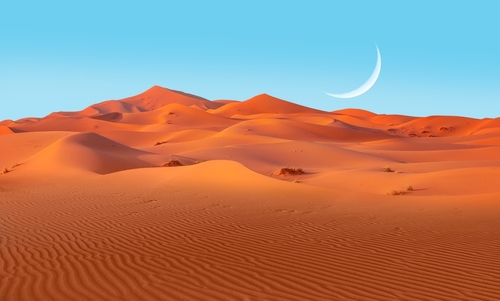
The Sahara (which simply means desert) is probably the most famous desert. It is the world’s largest, covering 3.6 million square miles across North Africa, and is famous for shaping the Egyptian civilization, which formed around the fertile Nile River that cuts through the Sahara in the west. It is a classic desert, with vast sand dunes, rocky plains, and the occasional oasis. Oases form around underground water sources that break through cracks in the Earth’s surface.
Temperatures in the Sahara soar above 120°F (49°C) during the day and plummet to as low as 25°F (-4°C) at night. Nevertheless, the semi-nomadic Tuareg people have occupied the Sahara for millennia. Known as the “blue men of the desert” due to the blue colored robes worn by the men, they call themselves Kel Tamasheq or Imohag, meaning “freemen,” while Tuareg is an Arabic word meaning “abandoned by God.”
The Sahara is famous for the Eye of the Sahara, a Richat Structure that is visible from space. It is a geological formation that resembles an enormous bullseye, 25 miles across. Plato described Atlantis as a series of concentric islands separated by waterways, leading some to suggest that the Eye of the Sahara is what remains of that ancient civilization.
Arabian Desert
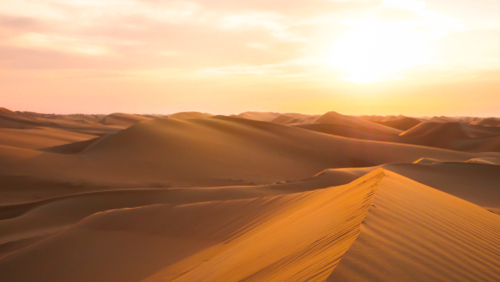
The Arabian Desert, which occupies much of the Arabian Peninsula, is the world’s fourth-largest desert. Like the nearby Sahara, it is around that 30° latitude sweet spot where many deserts form. Locals call it the Rub’ al Khali, or “empty quarter,” and it is the world’s largest continuous sand desert, with towering dunes over 800 meters high. While this makes the region inhospitable, it also makes it a popular destination for 4×4 adventures from Dubai and Abu Dhabi.
The nomadic Bedouin people have lived in the Arabian Desert since before Biblical times, adapting to the harsh conditions. They navigate using the few constant landmarks unaffected by moving sands, deliberately placed trail-marking stones, and celestial maps to travel during the cooler nights. Organized into large tribal groups led by sheiks, some groups created permanent settlements from which they could exploit the vast oil reserves beneath the sand, bringing significant wealth to the region.
Sonoran Desert
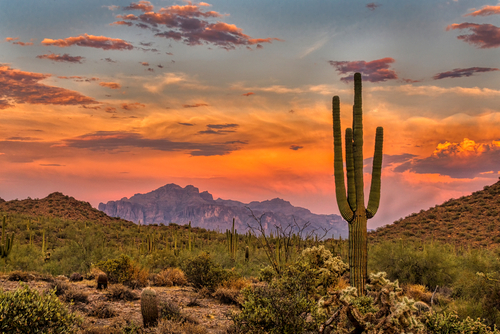
The Sonoran Desert, located in the southwestern United States and northwestern Mexico, is a uniquely biodiverse hot and dry desert. This is enabled by a bi-seasonal rainfall pattern, with limited rains in the winter between December and March and then again in the summer between July and September, rather than just once a year. This creates the conditions for America’s iconic saguaro cactus, which has become a symbol of the American desert. Animals have also adapted to the conditions, coming out at night and burrowing into the ground to find cooler surfaces.
American cities such as Phoenix and Tucson were built in the desert. The cities copied extensive canal systems built by pre-Colombian indigenous people, creating stable water supplies through projects like the Theodore Roosevelt Dam and the Central Arizona canal system.
Cold deserts: Where ice meets sand
Gobi Desert
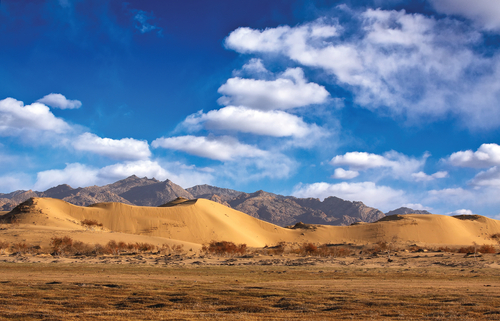
Spreading across parts of northern China and southern Mongolia, the Gobi Desert is a cold desert, with winter temperatures as low as 40°F (-40°C), though in the summer temperatures can spike as high as 122°F (50°C). The desert sits behind the Himalayas and the Tibetan Plateau, and these elevated regions block rainfall, creating a “rain shadow.”
However, the Gobi region was a lush and humid environment with freshwater lakes during the Cretaceous Period, which attracted Jurassic life. It is now a treasure trove for dinosaur fossils, including the discovery of the world’s first dinosaur eggs in the 1920s. Mongolian nomadic herders still live in the region, carrying mobile yurts and herding livestock such as Bactrian camels and cashmere goats.
Great Basin Desert
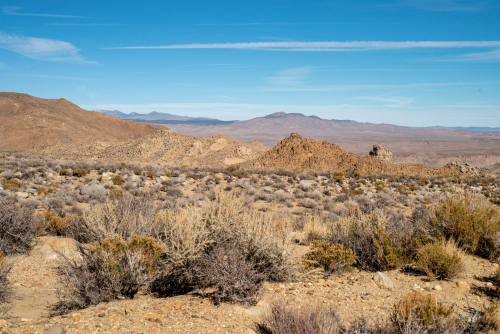
The Great Basin Desert is the largest in the United States, covering most of Nevada and parts of Utah, California, Idaho, and Oregon. This is another “rain shadow” desert, with the Sierra Nevada mountains blocking moist air from the Pacific. The result is a vast sagebrush ecosystem that supports unique wildlife, such as the mule deer and pronghorn.
The Great Basin Desert was a major obstacle for pioneers moving west. It necessitated the creation of established trails that passed water sources and were supported by trade posts, such as the California Trail and the Mormon Pioneer Trail. Today, the desert is under threat as new invasive species, especially cheatgrass, fuel frequent wildfires.
Coastal Deserts: Where Ocean Meets Arid Land
Atacama Desert
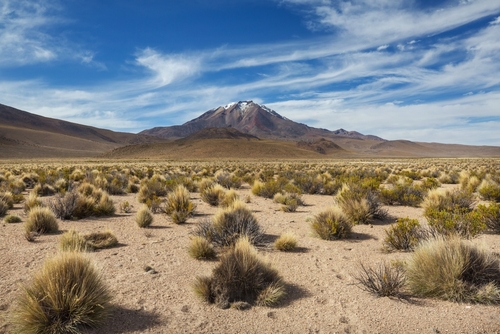
Despite its coastal location, Chile’s Atacama Desert is the world’s driest non-polar desert. It is so dry that some weather stations have never recorded rainfall. This is caused by the Humboldt Current, a cold ocean current that cools the air and prevents the formation of rain-producing clouds. Combined with a lack of light pollution and high altitude, perpetual clear skies make it one of the best places on Earth for stargazing.
Atacama is often described as a Mars-like landscape and has been used by NASA for research and testing of rovers for Mars exploration.
Namib Desert
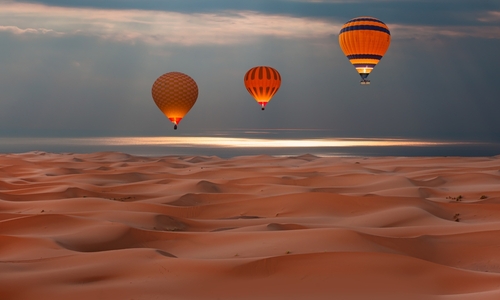
The Namib, which stretches for over 1,200 miles along the Atlantic coasts of Angola, Namibia, and South Africa, is considered the world’s oldest desert, having been in a desert state for 55 to 80 million years. It’s famous for the Sossusvlei, which is a dry lakebed surrounded by dramatic red dunes, and the Namib Skeleton Coast, a stark shoreline littered with shipwrecks and whale bones.
The little water that the Namib Desert does receive comes from fog rolling in from the Atlantic. Many plants and animals have developed incredible fog-harvesting adaptations, such as the darkling beetle, which climbs a dune and tilts its body to let condensing fog drip into its mouth.
Semiarid deserts: The middle ground
Great Victoria Desert
Australia is well-known for its vast desert interior, but the Great Victoria Desert, in the southwest, is the country’s largest. Semi-arid conditions mean that there are grassland expanses between sand dunes and salt lakes. Many unique Australian animals have adapted to the region, including the cute burrowing bilby, a nocturnal marsupial that burrows for protection from the sun, and the short-beaked echidna, one of only four surviving Australian anteater species.
Aboriginal groups like the Pila Nguru and Pitjantjatjara have occupied this desert for at least 25,000 years, living a hunter-gatherer lifestyle with specialized water conservation techniques. The landscape plays an important role in many stories from their Dreamtime, telling of how the world came to be. However, many Aboriginal people were displaced by nuclear weapons testing in the region in the 1950s, as well as extensive gold and uranium mining that threatens the fragile desert ecosystem.
Life in the desert: Incredible adaptations
While deserts present extremely harsh conditions, incredible adaptations mean that life can still thrive in these arid regions. Desert plants have developed ingenious ways to conserve water. For example, the iconic saguaro cactus has expandable, accordion-like stems that allow it to collect and store rainwater, while the mesquite tree can have roots that burrow over 100 feet to find groundwater. Animals have also developed survival strategies, such as nocturnal hunting, burrowing for shade and cool, and kidneys that reabsorb water from urine.
Human societies have also adapted to life in the desert, mostly around nomadic and semi-nomadic patterns. Often looking to nature for inspiration on how to solve problems, called biomimicry, humans have developed specialized clothing, unique plant medicines, and water collection based on the fog-harvesting abilities of certain animals. These adaptations emerged from a deep understanding of the landscape, often developed over millennia.
Desert conservation and climate change
While many would consider the desert the last place on Earth they want to live, urbanization and exploitation are threatening fragile desert ecosystems and encroaching on traditional desert lifestyles. Mining is a major problem, but other issues are caused by settlements themselves, like Phoenix and Tucson, which disrupt natural moisture patterns. Climate change, largely caused by an increase in human-generated heat, is also changing rainfall patterns that disrupt established desert ecosystems.
Deserts are essential for global climate regulation as they absorb significant amounts of solar radiation and reflect it back into space, having a net cooling effect on the planet. Arid soil also stores carbon, reducing atmospheric carbon. This is why desert conservation efforts, such as the Mojave National Preserve and the Gobi Gurvan Saikhan National Park, are essential and need support.
Visiting deserts safely
While deserts are beautiful landscapes and money raised from ethical tourism can support conservation, deserts can be dangerous and should be respected. Keep these essential safety tips in mind when visiting the desert:
- Bring plenty of water, as there is no guarantee when you will find your next water source. The recommendation is at least one gallon of drinking water per person per day.
- Visit during the spring and fall seasons, when temperature highs and lows are less extreme.
- Cover up with protective clothing. While it might be hot, this is not shorts weather as UV conditions are strong. Cover up with light material, such as linen, and wear a wide hat, sunglasses, and sunblock.
- Stay on marked trails that have been mapped out by people who know the area and where to find water. Also, stick to the trail, as it is easy to get disoriented in the homogeneous landscape.
- Tell someone where you are going and when you expect to return so they can raise the alarm if something happens.
When you choose to travel to the desert, remember to do your part to preserve these unique landscapes. Choose ethical travel providers that use eco-friendly vehicles and accommodations that conserve water, and practice “leave no trace” principles, taking everything you bring away with you.
Conclusion: Appreciating Earth’s arid wonders
Deserts are among the world’s most misunderstood environments. While deserts are arid regions characterized by minimal rainfall, they are far from barren wastelands—they’re unique environments that support rich biodiversity.
The deserts of the world support exceptional biodiversity, uniquely adapted to these dry conditions, and fascinating human societies that have learned to live in balance with these harsh desert environments.
Deserts are also essential to the health of our planet, helping lower global temperatures and reduce atmospheric carbon. This is why protecting the world’s deserts is a global responsibility that we all share, so that the quiet majesty and enduring resilience of the world’s deserts can continue to inspire generations to come.
FAQs
How many major deserts exist worldwide?
It is estimated that there are 33 major deserts worldwide, although this is up for debate. There is no official agreement on the definition of a desert, and it’s often difficult to say where one desert ends and another begins.
Can people live permanently in desert environments?
Yes, people have lived and thrived in the desert for millennia, with ancient cultures such as the Tuareg, Bedouin, and some Australian Aboriginal tribes adapting culturally to live in harmony with these arid conditions. Modern cities are also sometimes built in deserts, though they use technology to establish secure water supplies. This can disrupt fragile natural ecosystems and the lives of native peoples.
What’s the difference between a desert and a wasteland?
A desert is an ecosystem that receives minimal rainfall, less than 10 inches a year, resulting in arid conditions. While conditions are harsh, deserts support unique biodiversity. “Wasteland” is a subjective term applied to barren or “useless” lands. But, as we have seen, a desert might seem like a wasteland to one person, and to another it may be an environment that, while harsh, is rich in resources.
How do desert animals find water?
Desert animals use a variety of different strategies to find the water they need to survive. Some extract the water they need purely from food. Others have adaptations that let them conserve every drop of water. Yet others have developed ingenious methods of gathering water, such as fog harvesting.
Are deserts expanding due to climate change?
Yes, deserts are expanding in a process called desertification. Changing rainfall patterns caused by climate change, overgrazing, and deforestation create new arid regions where existing plants and animals have not yet adapted and therefore cannot thrive. In contrast to ancient desert formation, which happened over millions of years, desertification is now happening quickly. It is estimated that around 75,000 square miles of productive land is turning into desert each year.
What should I pack for a desert trip?
When planning a desert trip, make sure you bring enough water—at least one gallon of drinking water per person per day. Choose lightweight clothing that fully covers you and protects you from harsh UV rays, plus a wide hat, sunglasses, and sunblock. Use durable shoes and bring a map and compass, as GPS is notoriously unreliable in many of the world’s deserts.